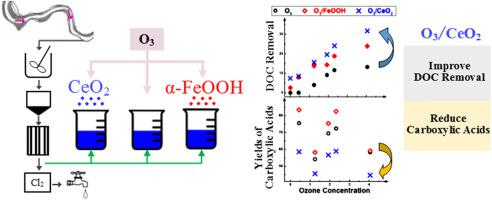Journal of Hazardous Materials ( IF 12.2 ) Pub Date : 2020-11-26 , DOI: 10.1016/j.jhazmat.2020.124674 Lianxue Wei , Kangxin Wen , Jinfeng Lu , Jun Ma

|
Catalytic ozonation was suggested to be effective for micropollutant removal during water treatment. However, research on organic byproduct formation from catalytic ozonation of real filtered water in water treatment plants was lacking. In this work, two synthesized catalysts, α-FeOOH and CeO2, were applied to catalyze ozonation of real filtered water at different ozone dosages, and the byproducts were quantified. Results showed that the α-FeOOH enhanced hydroxyl radical production, while the CeO2 did not. Both catalysts further reduced dissolved organic carbon (DOC) and UV254 of the filtered water during the catalytic oxidation processes. The O3/CeO2 improved the removal of low molecular weight compounds, especially the refractory compounds such as ketoacids and carboxylic acids, compared to ozonation alone. While the O3/α-FeOOH generated higher concentrations of carboxylic acids than that of ozonation. Thus, in light of DOC and low molecular weight compound reductions, CeO2 was the superior catalyst for micropollutant removal in real filtered water.
中文翻译:

量化通过不同路径催化臭氧氧化后的真实过滤水产生的低分子量氧化副产物的数量
建议在水处理过程中催化臭氧氧化对去除微量污染物有效。但是,缺乏对水处理厂中实际过滤后的水进行催化臭氧氧化形成有机副产物的研究。在这项工作中,使用了两种合成的催化剂α-FeOOH和CeO 2,以不同的臭氧剂量催化实际过滤水的臭氧化,并对副产物进行了定量。结果表明,α-FeOOH增强了羟基自由基的产生,而CeO 2却没有。两种催化剂在催化氧化过程中均进一步降低了过滤水中的溶解有机碳(DOC)和UV 254。O 3 / CeO 2与单独的臭氧化相比,改进了对低分子量化合物(尤其是难熔化合物,例如酮酸和羧酸)的去除。而O 3 /α-FeOOH生成的羧酸浓度高于臭氧化处理。因此,考虑到DOC和低分子量化合物的减少,CeO 2是在实际过滤水中去除微污染物的优良催化剂。











































 京公网安备 11010802027423号
京公网安备 11010802027423号